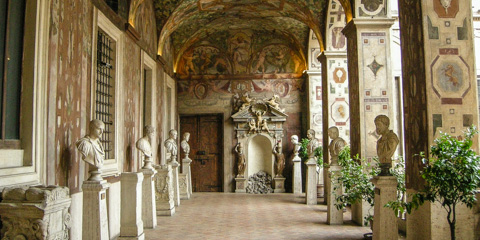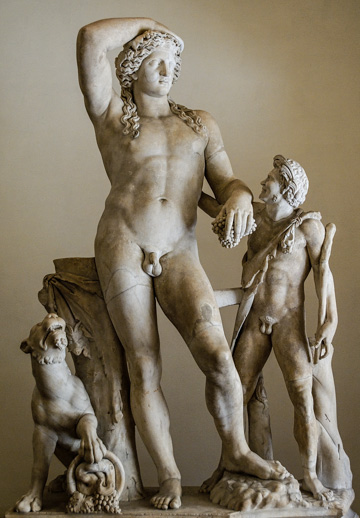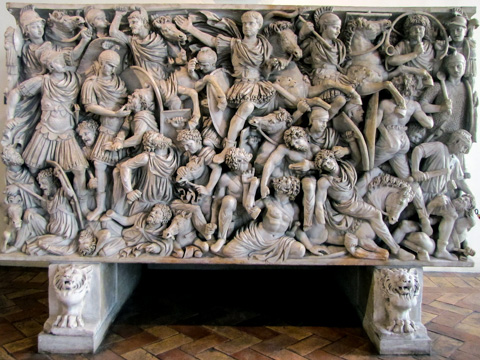

The new home to the famed Ludovisi and Mattei collections of ancient sculpture is a crown jewel in Rome's touristic renaissance, and a prime example of Italy's seemingly newfound ability to craft a 21st-century museum that respects both the gorgeous architecture and frescoes of the Renaissance space in which it is installed, and the aesthetic and historic value of the classical collection it contains.
Rather than stuff lots of statues into every nook and cranny of this Altemps space, they've placed just a few choice pieces in each room, allowing and encouraging you to examine each statue carefully, walk around it, and read the accompanying placard in English and Italian that explains its significance and shows which bits are original and which were "restored" in the 17th century.

The 16th- to 18th-century palazzo itself is gorgeous, with a grand central courtyard and many surviving frescoes and original painted wood ceilings, especially upstairs, where you can wander onto a bust-lined, Alberti-inspired loggia frescoed as a "Garden of Delights" in the 1590s.
The collections mix Roman originals with many Greek, Hellenstic, or Roman copies of Greek works, as well as a handful of older Egyptian sculptures collected by the ancient Romans.

Be on the lookout for an AD 2nd-century giant Dionysus with Satyr; 2nd-century BC Ptolemaic Egyptian statuary; a pair of lute-playing Apollos; and plenty of Imperial busts.
There's also a 1st-century BC copy of master Greek sculptor Phidias' most famous statue (now lost): The 5th-century BC Athena that once held the place of honor in Athens' Parthenon (pictured above).
One touching piece is the Ludovisi Gaul in the act of commiting suicide while he holds the arm of his dying wife.
This is a Roman copy of a Hellenistic original, which was commissioned by Attalus I of Pergamon for a monument he had built around 220 BC to celebrate his victory over Galatia (modern-day Anatolia, Turkey—though most commonly associated these days with the area we now call France, the Gauls—a Celtic people—had actually settled much of Europe, the Balkans, and Turkey by the 3rd century BC).

The Grande Ludovisi sarcophagus (AD 251/252). (Photo by Steven Zucker)
The royal guy in the middle of the top row, directing the battle, probably represents Hostilian, son of Emperor Decius.
This is both ironic and sad, since is was his father and older brother Herennius Etruscus (already named co-emperor with their dad) who actually fought the barbarian armies at the Danube frontier—and earned themselves the distinction of being, in AD 251, the first Roman emperors to be killed in battle by a foreign enemy (on the same day, no less).
Hostilian had been left at home as he as too young to go to war. He enjoyed the imperial throne he inherited for only a few months before succumbing to a plague that swept Rome. He was probably only 20 or 21 at the time.
Piazza di Sant'Apollinare 46 (two blocks north of Piazza Navona)
tel. +39-06-684-851
archeoroma.beniculturali.it
or
www.coopculture.it
Tues–Sun 9am–7:45pm
€7
Roma Pass: Yes (free, or 35% off)
Bus: 30, 70, 81, 87, 130F, 186, 492, 628, 116, 166T, N6, N7
Hop-on/hop-off: Vaticano
Planning your day: Figure on spending about 1 hour to 90 minutes here (ancient history buffs: give it at least 2 hours).
The ticket office closes an hour before the museum.
The regular ticket to any one MNR museum includes entry to all branches of the Museo Nazionale Romano for the amazing low price of €7 (you get a week in which to visit them all). However, note that if any branch of the musuem has a special exhibition going (which they almost always do), the ticket price rises to €10.
In other words: Expect admission to be €10, and be pleasantly surprised if they happen to be between exhibitions when you are in town and the price drops to €7.
This is a fantastic deal—though also consider using this as one of the two freebies you get with the Roma Pass (though there are few more expensive sights—the Forum/Colosseum, or the Galleria Borghese—on which you might spend your two "get in free" coupons). » more
I advise against the Archeologia Card,which you will also see offered. This card covers entry to these museums plus the Downtown Ancient Rome group (Roman Forum, the Colosseum, and the Palatine Hill; normally €12), and the Appian Way group (Baths of Caracalla, Tomb of Cecilia Metella, Villa of the Quintili; normally €6).
Sounds good, right? Some major-league sights in there, yes? True: But the savings is actually only €3—and you can get more bang for your sightseeing buck by using the Roma Pass instead to cover the Forum/Colosseum (plus either this group or something else major like the Galleria Borghese). » more
The museum itself offers (free) tours only in Italian.
Take a guided tour of Palazzo Altemps in English with one of our partners:
Share this page
Search ReidsItaly.com
Piazza di Sant'Apollinare 46 (two blocks north of Piazza Navona)
tel. +39-06-68-4851
archeoroma.beniculturali.it
or
www.coopculture.it
Tues–Sun 9am–7:45pm
€7
Roma Pass: Yes (free, or 35% off)
Bus: 30, 70, 81, 87, 130F, 186, 492, 628, 116, 166T, N6, N7
Hop-on/hop-off: Vaticano